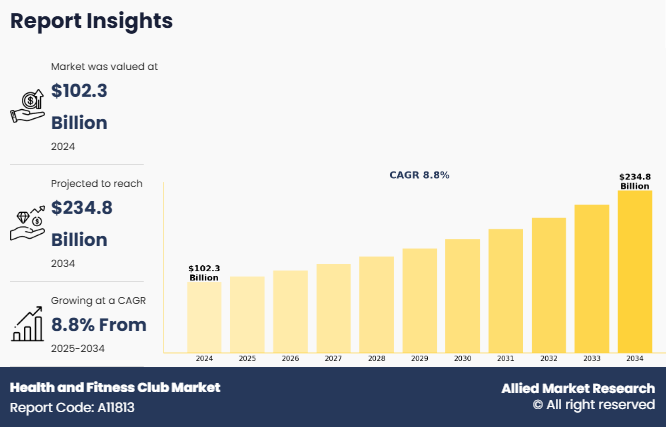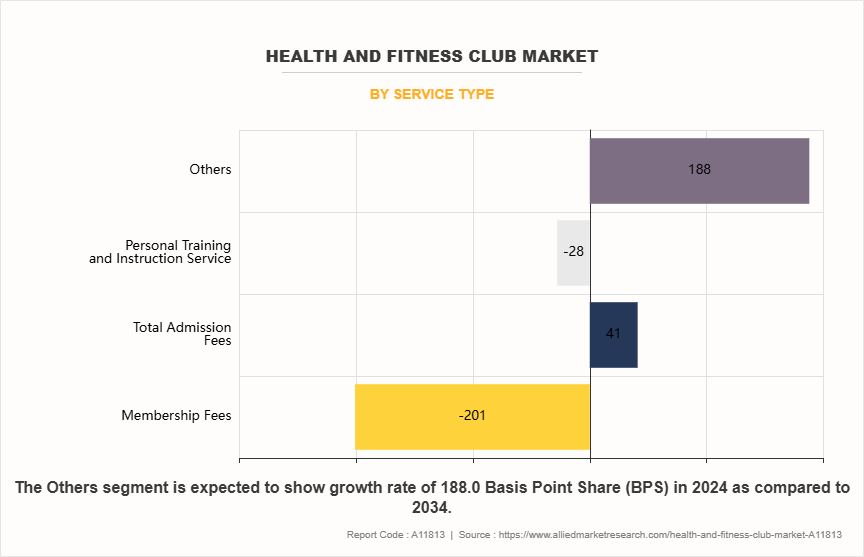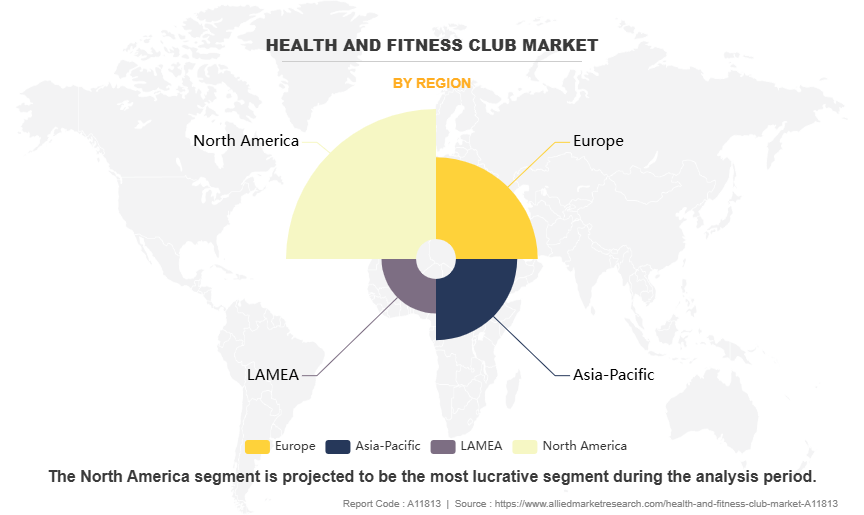Health And Fitness Club Market Research, 2034
The global health and fitness club market size was valued at $102.3 billion in 2024, and is projected to reach $234.8 billion by 2034, growing at a CAGR of 8.8% from 2025 to 2034. A health and fitness club is a facility designed to promote physical fitness, wellness, and overall health through a range of services and programs. Health and fitness clubs typically offer access to exercise equipment, group fitness classes, personal training, and wellness amenities such as swimming pools, saunas, and nutrition counseling. Many health and fitness clubs operate on a membership basis and provide structured fitness routines, rehabilitation support, and lifestyle improvement programs. Some health and fitness clubs integrate technology for health tracking and personalized fitness solutions.

MARKET DYNAMICS
Rise in prevalence of obesity and lifestyle-related diseases has significantly boosted the demand for health and fitness clubs. Individuals have become more conscious of the health risks associated with sedentary habits, prompting a shift toward physical activity as a key component for disease prevention and overall well-being. According to a 2023 data from the Centers for Disease Control and Prevention, over 1 in 3 adults (35%) in 23 U.S. states were obese, a statistic that had not appeared in any state in the U.S. prior to 2013. At least 1 in 5 adults (20%) in every U.S. state were living with obesity in 2023, contributing to the surge in demand for fitness services within the health and fitness club market. Increase in obesity rate directly impacts the health and fitness club market share, as people seek to lose weight, improve health, and adopt healthier lifestyles.
In addition, rise in incidence of chronic conditions, such as diabetes, heart disease, and hypertension, drives the demand for health and fitness clubs. The International Diabetes Federation projected that 1 in 8 adults, approximately 853 million, are expected to live with diabetes globally by 2050. Surge in prevalence of such chronic conditions and obesity highlights the need for preventive healthcare in recent years. Health and fitness clubs offer customized fitness programs and wellness solutions to help individuals adopt active lifestyles, leading to improved long-term health outcomes. As more individuals prioritize health and fitness, the health and fitness club market is anticipated to grow, driven by the rise in demand for tailored fitness and wellness services.
However, high membership costs and service charges restrain market expansion of the health and fitness club market. Premium fees for joining and maintaining memberships create financial barriers, especially for middle and lower-income groups. In several regions, monthly dues, initiation fees, and extra costs for services such as personal training or wellness programs discourage many individuals from choosing health and fitness clubs. Facilities positioned as luxury and boutique clubs charge even higher fees, which makes access limited to only a small segment of consumers, thus hindering the growth of health and fitness club market.
Moreover, high service charges for additional amenities such as spa treatments, specialized group classes, and nutrition counseling further reduce the attractiveness of joining health and fitness clubs. Lack of flexible pricing structures leads to lower membership retention rates. Health and fitness clubs unable to adjust to varying income levels experience slower growth. The financial burden created by high costs directly limits the health and fitness club market and restricts expansion across a wider audience seeking more affordable fitness solutions.
Furthermore, the growth in corporate partnerships for employee wellness packages creates strong opportunities for the health and fitness club market. Businesses increasingly recognize the importance of employee health in improving productivity and reducing absenteeism. Companies are partnering with health and fitness clubs to offer subsidized memberships, onsite fitness facilities, and customized wellness programs. These partnerships allow health and fitness clubs to access a large pool of potential members while providing employers with structured health improvement initiatives. Programs such as gym reimbursements, group fitness sessions, and health assessments have become attractive benefits in competitive job markets, driving the market growth during health and fitness club market forecast.
Moreover, corporate wellness partnerships have emerged as a significant contributor to health and fitness club market growth. Organizations prioritize comprehensive wellness strategies that include physical activity, mental health support, and lifestyle management, creating long-term engagement with health and fitness clubs. Such initiatives align with broader health and fitness club market trends focused on holistic wellness. Health and fitness clubs that tailor services for corporate clients, such as flexible membership plans, specialized classes, and performance tracking solutions, strengthen market presence. Expansion of workplace wellness initiatives continues to create sustainable opportunities, positioning health and fitness clubs as essential partners in corporate health strategies.
SEGMENTAL OVERVIEW
The health and fitness club market is segmented into service type and region. By service type, the market is divided into membership fees, total admission fees, personal training & instruction service, and others. By region, the market is analyzed across North America (U.S., Canada, and Mexico), Europe (Germany, UK, France, Italy, Spain, Russia, and rest of Europe), Asia-Pacific (China, Japan, India, South Korea, Australia, Thailand, Malaysia, Indonesia, and rest of Asia Pacific), and LAMEA (Brazil, Argentina, South Africa, Saudi Arabia, UAE, and rest of LAMEA).
BY SERVICE TYPE

By service type, the membership fees segment dominated the global health and fitness club market in 2024 and is anticipated to maintain its dominance during the forecast period. Membership fees offer a consistent revenue stream for clubs, which enables long-term financial planning and investment in facility upgrades, new equipment, and expanded services. Health and fitness clubs have increasingly structured their business models around recurring membership payments, which provide stability against seasonal fluctuations in customer attendance. The availability of flexible membership plans, including monthly, quarterly, and annual subscriptions, has further encouraged consumer retention.
Moreover, the rise in health consciousness and demand for personalized fitness experiences has strengthened the preference for membership-based models. Clubs offering exclusive access to wellness programs, personal training, and specialty classes attract a steady client base willing to commit to ongoing memberships. In addition, urbanization and higher disposable income levels, especially in emerging economies, continue to boost participation of individuals in organized health and fitness clubs, sustaining the growth of membership fees segment within the market.
BY REGION

By region, North America is anticipated to dominate the global health and fitness club market with the largest share during the forecast period. In the U.S., the market is supported by strong participation in organized wellness programs, growing adoption of holistic health services, and a high rate of consumer spending on preventive care. States such as California, New York, and Massachusetts have witnessed a rise in demand for multi-service health and fitness clubs offering access to group classes, wellness coaching, spa services, and mind-body programs such as yoga and meditation, which has driven adoption rates of health and fitness clubs in North America.
Consequently, operators in the U.S. have expanded service offerings such as nutrition consulting, mental wellness workshops, and recovery therapies, which is anticipated to drive more individuals toward health and fitness clubs. Many clubs have also integrated personalized wellness assessments and lifestyle management plans to address a wider range of consumer health goals. Thus, shift toward inclusive and comprehensive wellness models has positioned health and fitness clubs in North America for continued dominance through increased engagement across age and income groups.
COMPETITIVE LANDSCAPE
The key players operating in the global health and fitness club industry include Crunch Fitness, LLC, Equinox Holdings, Inc., Gold’s Gym International Inc., LTF Holdings Inc., Planet Fitness Inc., SATS Group, Self Esteem Brands LLC, Snap Fitness, The Bay Club Company, LLC, and UFC Gym, LLC. Several well-known and upcoming brands are vying for market dominance in the expanding health and fitness club market. Smaller, niche firms are more well known for catering to consumer demands and preferences in the global market. Large conglomerates, however, control most of the market and often buy innovative start-ups to broaden their reach globally.
Key Benefits For Stakeholders
- This report provides a quantitative analysis of the market segments, current trends, estimations, and dynamics of the health and fitness club market analysis from 2024 to 2034 to identify the prevailing health and fitness club market opportunities.
- The market research is offered along with information related to key drivers, restraints, and opportunities.
- Porter's five forces analysis highlights the potency of buyers and suppliers to enable stakeholders make profit-oriented business decisions and strengthen their supplier-buyer network.
- In-depth analysis of the health and fitness club market segmentation assists to determine the prevailing market opportunities.
- Major countries in each region are mapped according to their revenue contribution to the global market.
- Market player positioning facilitates benchmarking and provides a clear understanding of the present position of the market players.
- The health and fitness club market report includes the analysis of the regional as well as global health and fitness club market trends, key players, market segments, application areas, and market growth strategies.
Health and Fitness Club Market Report Highlights
| Aspects | Details |
| Market Size By 2034 | USD 234.8 billion |
| Growth Rate | CAGR of 8.8% |
| Forecast period | 2024 - 2034 |
| Report Pages | 250 |
| By Service Type |
|
| By Region |
|
| Key Market Players | UFC Gym, LLC., Self Esteem Brands LLC, SATS Group, Equinox Holdings, Inc., Crunch Fitness, LLC., LTF Holdings Inc., Snap Fitness, Planet Fitness Inc., The Bay Club Company, LLC, Gold’s Gym International Inc. |
Analyst Review
This section consists of the opinions of the top CXOs in the health and fitness club market. CXOs in the health and fitness club industry highlight personalization, service variety, and regional expansion as primary growth strategies. Many executives prioritize the development of both in-club and digital service options to meet change in consumer expectations. Flexible memberships, tailored fitness routines, and integrated nutrition planning are considered essential for increasing member engagement. Several leaders adopt these services, including mental wellness programs, recovery support, and lifestyle coaching.
Executives in North America and Europe plan to increase investment in technology to support data-informed fitness planning, simplify operations, and provide targeted services. Growth prospects are also strong in regions such as Asia-Pacific, the Middle East, and parts of Africa, where improving access to health infrastructure and growing awareness of active lifestyles continue to increase memberships. Many CXOs focus on partnerships with healthcare institutions, corporate wellness programs, and sports training centers to expand service reach.
Female-oriented offerings, youth & senior-specific programs, and specialized boutique services are becoming popular in the global health and fitness club market. Executives believe that offering goal-based, personalized services supported by local insights are projected to create long-term business growth. Health and fitness club leaders anticipate continued market expansion, driven by rise in health concerns and increase in interest in structured wellness environments.
The global health and fitness club market was valued at $102,259.5 million in 2024, and is projected to reach $234,813.5 million by 2034, registering a CAGR of 8.8% from 2025 to 2034.
The forecast period in the Health and fitness club market report is 2025 to 2034.
The base year calculated in the Health and fitness club market report is 2024.
The top companies analyzed for the global Health and fitness club market report are The Bay Club Company LLC, UFC Gym, LLC., Crunch Fitness, LLC., Two Sports International Holdings Inc., Planet Fitness Inc., Equinox Holdings Inc., SATS Group, Gold’s Gym International Inc., LTF Holdings Inc., and Self Esteem Brands LLC.
The membership fees segment is the most influential segment in the Health and fitness club market report.
North America holds the maximum market share of the Health and fitness club market.
The company profile has been selected on the basis of key developments such as partnerships, product launches, mergers, and acquisitions.
The market value of the Health and fitness club market in 2024 was $102,259.5 million.
Loading Table Of Content...
Loading Research Methodology...



